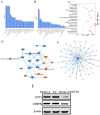OTX2 expression contributes progression of gastric cancer in young adults
- PMID: 40341176
- PMCID: PMC12062444
- DOI: 10.1038/s41598-025-99632-2
OTX2 expression contributes progression of gastric cancer in young adults
Abstract
Gastric cancer of young adults is poorly differentiated and has a poor prognosis. However, there are few reports regarding the genetic alteration in gastric cancer of young adults. Bioinformatics methods were used to screen the key genes and signaling pathways of gastric cancer in young adults, and molecular biology techniques were used to verify the key proteins involved in the occurrence and development of gastric cancer in young adults. RNA expression profile microarray data of gastric cancer patients ≤ 45 years old and > 45 years old were downloaded from the TCGA database, and differentially expressed genes were screened by Limma package. GO analysis and KEGG enrichment analysis of DEG were performed in the Gene Function annotation database (DAVID). CytoHubba is used to construct protein interaction networks (PPI) and perform visual analysis to screen out core genes. We obtained 10 hub molecules, including FBXO44, FBXO6, HERC5, FBXL13, FBXO41, NT5E, BMP4, TRIM36, ACAN, ALPL by PPI network with MCODE. Ingenuity Pathway Analysis predicts TBX1, DFNB31, TGFBR3, FBXO44, SLC7A8, DNM1, KITLG, MSH5, MLLT3, DUSP5, ADAMTSL4, ACPP and TBX1 as the transcription factors directly regulated by OTX2. OTX2 had the highest positive expression rate in gastric cancer of young adults by immunohistochemistry. Interference with OTX2 expression inhibits proliferation, migration, invasion and promotes differentiation, apoptosis of NUGC-4 cells (from 35 year old female). Moreover, after interfering OTX2 expression, the downstream proteins and signaling Pathways of OTX2 in NUGC-4 were further analyzed by Transcriptome sequencing and Ingenuity Pathways Analysis. We found interference with OTX2 expression inhibits CEBPB expression and activates calcitriol by IPA analysis, thereby promoting differentiation of NUGC-4. Therefore, OTX2 plays important roles in restraining the differentiation and promoting progression of gastric cancer cells in young adults. Moreover, OTX2/CEBPB signal axis is likely to be a key molecular event in regulating the differentiation of gastric cancer cells in young adults.
Keywords: Differentiation; Gastric cancer; OTX2; Progression; Young adults.
© 2025. The Author(s).
Conflict of interest statement
Declarations. Competing interests: The authors declare no competing interests.
Figures




Similar articles
-
Integrated bioinformatics analysis for differentially expressed genes and signaling pathways identification in gastric cancer.Int J Med Sci. 2021 Jan 1;18(3):792-800. doi: 10.7150/ijms.47339. eCollection 2021. Int J Med Sci. 2021. PMID: 33437215 Free PMC article.
-
FN1, SPARC, and SERPINE1 are highly expressed and significantly related to a poor prognosis of gastric adenocarcinoma revealed by microarray and bioinformatics.Sci Rep. 2019 May 24;9(1):7827. doi: 10.1038/s41598-019-43924-x. Sci Rep. 2019. PMID: 31127138 Free PMC article.
-
Bioinformatics-Based Identification of Methylated-Differentially Expressed Genes and Related Pathways in Gastric Cancer.Dig Dis Sci. 2017 Nov;62(11):3029-3039. doi: 10.1007/s10620-017-4740-6. Epub 2017 Sep 15. Dig Dis Sci. 2017. PMID: 28914394
-
Transcriptome analysis reveals GPNMB as a potential therapeutic target for gastric cancer.J Cell Physiol. 2020 Mar;235(3):2738-2752. doi: 10.1002/jcp.29177. Epub 2019 Sep 9. J Cell Physiol. 2020. PMID: 31498430
-
Combined bioinformatics technology to explore pivot genes and related clinical prognosis in the development of gastric cancer.Sci Rep. 2021 Jul 29;11(1):15412. doi: 10.1038/s41598-021-94291-5. Sci Rep. 2021. PMID: 34326374 Free PMC article.
References
-
- Tang, W. Z. et al. Prevalence and unfavorable outcome of frailty in older adults with gastric cancer: A systematic review and meta-analysis. Support Care Cancer32, 115 (2024). - PubMed
-
- Jia, X. et al. Global burden of stomach cancer attributable to smoking from 1990 to 2019 and predictions to 2044. Public Health226, 182–189 (2024). - PubMed
MeSH terms
Substances
Grants and funding
LinkOut - more resources
Full Text Sources
Medical
Research Materials
Miscellaneous

